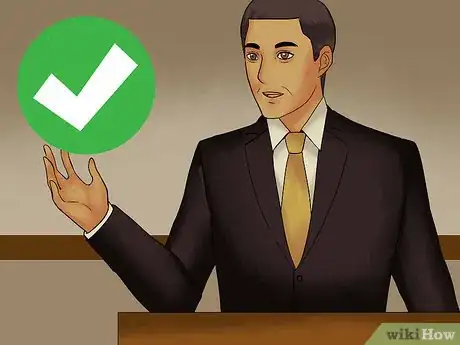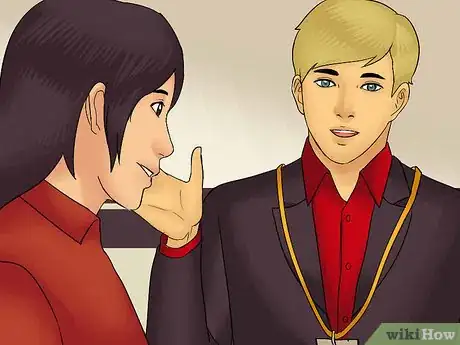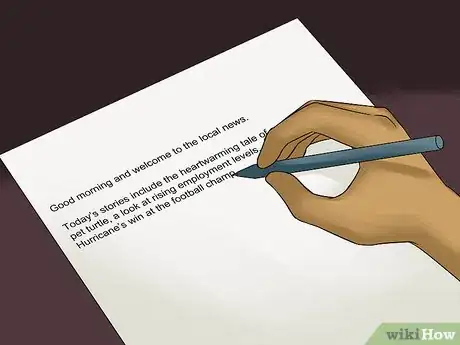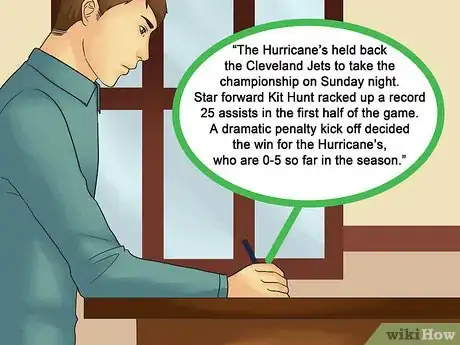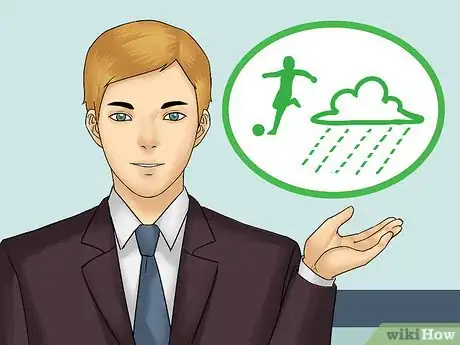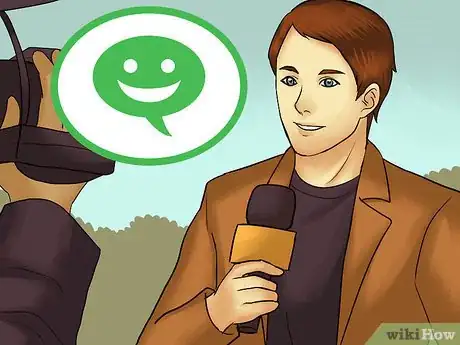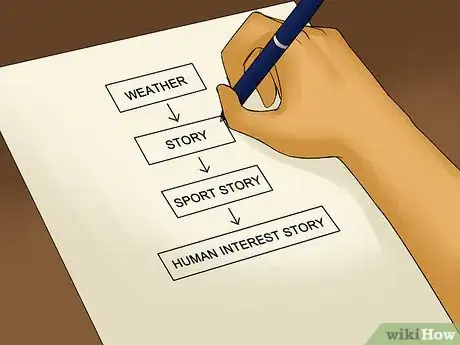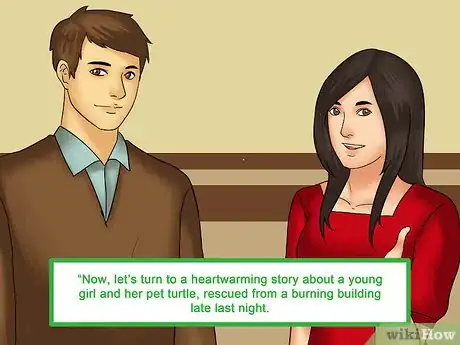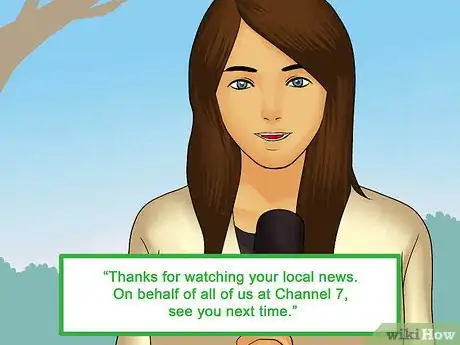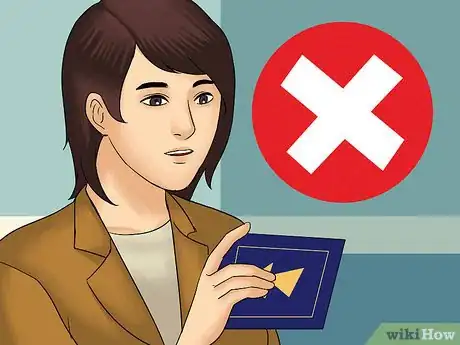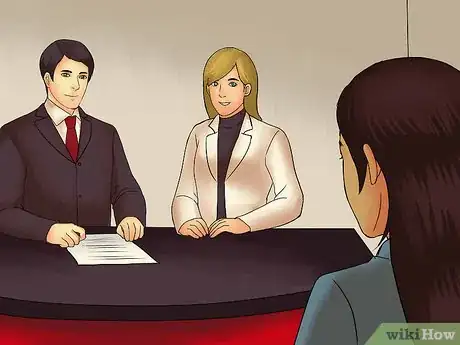This article was co-authored by wikiHow Staff. Our trained team of editors and researchers validate articles for accuracy and comprehensiveness. wikiHow's Content Management Team carefully monitors the work from our editorial staff to ensure that each article is backed by trusted research and meets our high quality standards.
wikiHow marks an article as reader-approved once it receives enough positive feedback. In this case, several readers have written to tell us that this article was helpful to them, earning it our reader-approved status.
This article has been viewed 110,071 times.
Learn more...
A newscast is a group of news segments that have been edited together. A typical newscast is 22 minutes long to allow time for advertisements. You may decide to create a newscast for a class or as a fun project with friends. Start by assigning roles for the newscast, like an anchor, reporter, and a producer. Then, write and present the newscast so it is a concise collection of journalism for viewers to enjoy.
Steps
Assigning Roles
-
1Find someone who is organized to be the producer. The producer of the newscast will be responsible for ordering the newscast. They will decide how the newscast flows from one news segment to another. They must be organized and willing to take on the challenge of putting the newscast together.
- If you are working with a large group of people, you may ask two people to serve as producers for the newscast. That way, the work of organizing the newscast is shared between two people.
-
2Choose a strong communicator to be the writer. A newscast is typically written by one writer, or a team of writers. Pick someone who is good at communicating on paper and who has an ear for writing dialogue. They will then write each news segment so the language and tone flow well together in the newscast.
- Another option is to ask each reporter to write their own news segment.
Advertisement -
3Pick someone with a good on-camera presence to be the anchor. The anchor is responsible for introducing each news segment in the newscast. They will act as the guide for the newscast. The anchor should be comfortable on camera and have a friendly, confident demeanor.
- You can choose two people to act as anchors for the newscast. The anchors can then take turns introducing the news segments.
-
4Assign several reporters to cover different stories. A typical newscast will have four to five news segments. Each news segment will cover one new story. Assign one reporter per story. The reporters will need to be comfortable appearing on camera and be prepared to discuss the details of the news story.
- If you have a limited number of reporters, you may ask the reporters to cover more than one news story.
Writing the Newscast
-
1Write the anchor’s introduction. Most anchor introductions begin by greeting the audience with “Good evening,” “Good morning,” or “Welcome.” The introduction will then briefly outline each news segment in the newscast.[1]
- For example, the anchor introduction might be, “Good morning and welcome to the local news. Today’s stories include the heartwarming tale of a girl and her pet turtle, a look at rising employment levels, and a clip of the Hurricane’s win at the football championships last night.”
-
2Create two to four minute news segments. The news segments should be short and to the point. Each news segment should provide the key details of the event and tell the viewer what happened in brief terms. The news segments are usually created by the writer, or writers.[2]
- For example, you may have a sports news segment like, “The Hurricane’s held back the Cleveland Jets to take the championship on Sunday night. Star forward Kit Hunt racked up a record 25 assists in the first half of the game. A dramatic penalty kick off decided the win for the Hurricane’s, who are 0-5 so far in the season.”
-
3Have a variety of new segments. Most newscasts have several different news stories. Put a sports story, a current news story, a weather update, and a human interest story all in the same newscast. Only include more than one of the same type of news story if it is very current or relevant.
- For example, if there are two news stories about robberies in the local area, you may include both news stories.
-
4Maintain a friendly, conversational tone in the news segments. The writer of the news segments should approach the content like they are talking to a friend. The tone should be friendly and conversational, with simple language that is easy to follow.
- Avoid sentences longer than two lines and run-on sentences. Use simple terms that are accessible for the audience.
-
5Order the news segments. Put the news segments in a particular order, starting with the most engaging story first. The producer will do this before the newscast is set to air, ordering the news segments so they flow together nicely. For example, the newscast may start with the weather and then transition into a story on employment levels, followed by a sports story, and a human interest story.[3]
- Choose a segment that has powerful visuals or is very current and in the moment as the first news segment. For example, you may pick a news story about a fire that occurred last night in a local school as the opening segment.
- Some newscasts start with current weather conditions to keep viewers watching and show them something relevant right away.
- Do not try to link together news segments that are clearly different or unconnected. Make the order as organic and natural as you can. Keep the viewer in mind as you organize the segments.
-
6Put in transitions between news segments. The anchor will appear between each news segment and say a few words to transition from segment to segment. Make sure you include transitions in the script for the newscast so the anchor knows what to say between stories.[4]
- For example, the anchor may say, “Now, let’s turn to a heartwarming story about a young girl and her pet turtle, rescued from a burning building late last night. Our city beat reporter Joanna has more.”
-
7Have an anchor sign off at the end of the newscast. The anchor should end the newscast with a short sign off. The sign off can be something simple like, “Thanks for watching your local news. On behalf of all of us at Channel 7, see you next time.”
Presenting the Newscast
-
1Make cue cards for the anchor and the reporters. Give the anchor and the reporters a guide so they know their lines during the newscast. You may make large cue cards that you hold behind the camera or in front of the reporters for them to read.[5]
- The anchor can also hold cards with notes for each segment and read from those.
-
2Encourage the anchor and reporters to avoid reading the cue cards. The anchor and reporters should use the cue cards as a guide and not simply read off of them. They should present their lines while looking up at the camera or the audience.
- Have the anchors to maintain eye contact with the camera during the newscast. They should demonstrate relaxed body language, with their shoulders back, their chin up, and their hands resting on the news desk.
-
3Position the anchor and reporters on the set. If you are presenting the newscast for a class, you may be able to stage it in front of an audience and do it live. You can also film the newscast using a video recorder or a camera. Position the anchor at a center table and have the reporters on either side of the anchor.
- If you know how to edit video, you can also shoot the newscast in multiple takes and edit it together to create an organized newscast.
-
4Practice the newscast several times before presenting it. Run through the newscast several times from beginning to end. Make sure the anchor and the reporters know their lines, with help from the cue cards. Check that the newscast flows well and seems engaging to viewers.[6]
References
- ↑ https://www.learnesl.net/newscasting-script-for-the-introduction/
- ↑ https://www.thoughtco.com/creating-a-newscast-esl-lesson-1212280
- ↑ https://www.thoughtco.com/creating-a-newscast-esl-lesson-1212280
- ↑ https://www.thoughtco.com/creating-a-newscast-esl-lesson-1212280
- ↑ http://www.write-out-loud.com/cue-cards.html
- ↑ https://www.thoughtco.com/creating-a-newscast-esl-lesson-1212280

